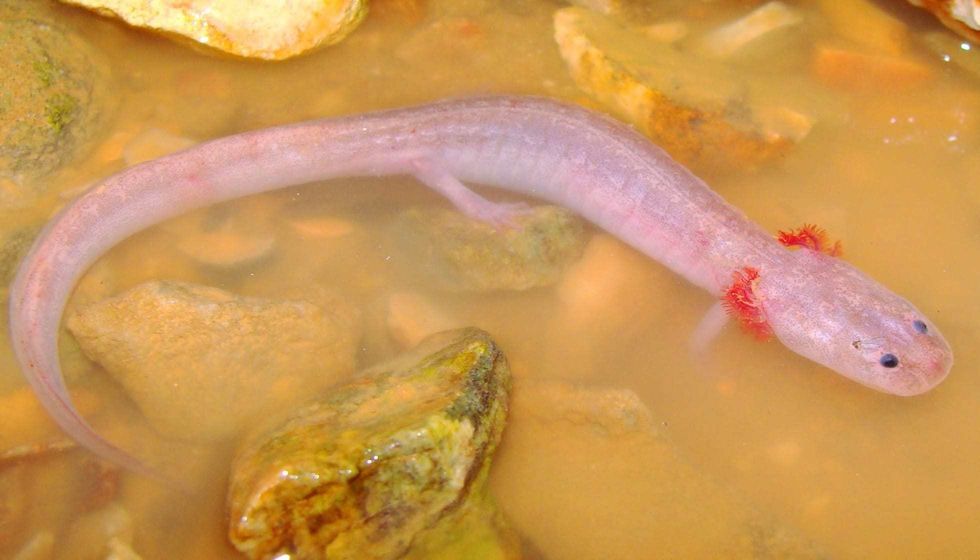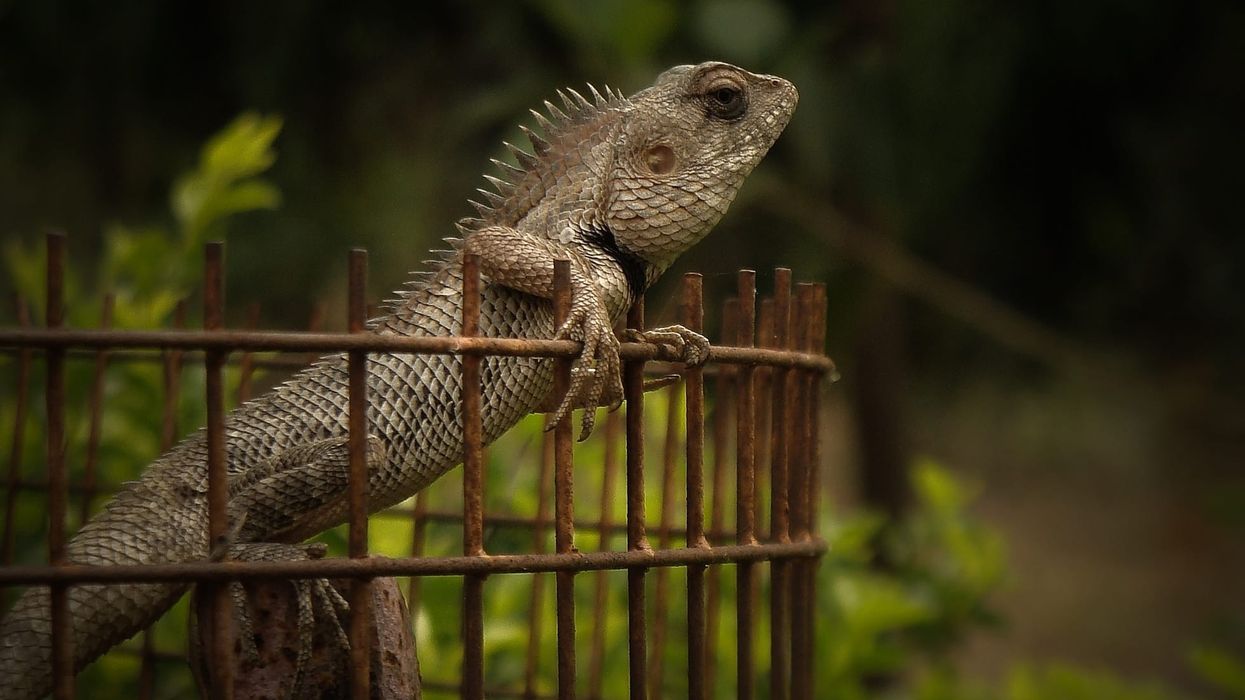Ever wondered if the little lizard-like creature you came across during the monsoon was even a lizard? The grotto salamander (Eurycea spelaea) also known as the Ozark blind salamander is a lungless, blind salamander species that is the only blind species of its kind in Missouri.
The grotto salamander is a very light creature and only weighs about 0.6 oz (17 g). Their weight changes depending on their age.
These salamanders are native to the United States and are popularly found beneath the Springfields of the Ozark Mountains, Kansas, and Missouri. They are sometimes recognized as amphibians and reptiles.
These are pinkish slimy creatures that strongly resemble lizards and produce harmful toxins. They are semi-aquatic, cave-dwelling animals that prefer to live in wet caves, freshwater springs, or streams.
They can lay up to 450 eggs at once. These salamanders are highly antisocial animals and prefer to live alone except during the breeding season.
These poor creatures are considered to be living in abundance in some places and are endangered in some and have been listed under the conservation status of Least Concern. The most fascinating thing about this species are their babies, also called larvae.
They are bold in color and have a brownish or purplish gray body. The larvae are extremely slimy, sometimes yellow on the sides.
The larvae tend to grow to be half the size of the adults. They have functional eyes and can see clearly but once they mature into adults, they turn blind and prefer to stay in the dark.
Read on to discover more fun facts about this animal! For more relatable content, check out these spring salamander facts and fire salamander facts for kids.
Grotto Salamander Interesting Facts
What type of animal is a grotto salamander?
The grotto salamander (Eurycea spelaea) is a semi-aquatic animal that can either live in a cave or in streams. This native Missouri species habitats mean these creatures are equipped to live both in and above water, making them very interesting to study.
What class of animal does a grotto salamander belong to?
The grotto salamander (Eurycea spelaea) belongs to the Amphibia class of the animal kingdom, family Plethodontidae. They are popularly found in a cave or a water body.
How many grotto salamanders are there in the world?
The exact population of the grotto salamander has not been accurately determined or accounted for yet. However, these creatures are considered to be living in abundance in some habitats and are endangered in others. They have been listed under the conservation status of Least Concern.
Where does a grotto salamander live?
The grotto salamander is usually found living in completely dark caves or sinkholes with either springs or streams flowing through them. This is why these salamanders are often referred to as cave-dwelling species.
They are native to the United States, specifically North America, and are popularly found in habitats of karst regions below the Springfield and Salem plateaus of the Ozark mountains and Missouri. These amphibians are also called Ozark blind salamanders for this very reason.
What is a grotto salamander's habitat?
The grotto salamander habitat usually consists of pitch dark caves or sinkholes that have springs or streams flowing through them. The cave in its natural habitat has to be carefully protected.
There should be no disturbance or underwater pollution as this can cause a threat to the grotto salamanders population in the region.
These salamanders are popular in regions of the United States, specifically North America and the karst regions below the Springfield and Salem plateaus of the Ozark mountains and Missouri.
Since these amphibians are found in abundance in caves, especially in the Ozark plateau and the Kansas region, they are often referred to as the cave salamander or Ozark blind salamander.
Who do grotto salamanders live with?
The grotto salamander species lives with many reptiles and amphibians like frogs, turtles, lizards, and snakes, and vertebrates that are native to Missouri. They can be found in a cave. Since these salamanders live in caves, they are also accompanied by bats and other amphibians and reptiles.
How long does a grotto salamander live?
It has been reported that the grotto salamander's lifespan can go up to 12 years when captive but the lifespan of these creatures in natural habitats is unknown and has not been studied yet.
How do they reproduce?
The grotto salamander does not interact with other salamanders of its kind unless it has to breed. This species only breeds when there is an abundant supply of food that is sufficient enough for the winter and early spring.
Fertilization of the eggs is an internal process for these amphibians. These creatures, like several other amphibians and reptiles, can lay over 400 eggs at once.
These eggs that they lay are usually attached to stones, preferably near water bodies in dark caves. The hatchlings are called larvae. These larvae are aquatic and similar to adults.
They too inhabit cave streams and sometimes also springs or streams that flow out of the caves. The time period that these larvae take to mature into fully grown adults is usually two to three years.
What is their conservation status?
The conservation status of these amphibians has been listed as a species of conservation concern. Earlier these amphibians were marked under the status of Least Concern.
Factors like water quality degradation and environmental contamination due to human involvement has led to the reduction in the number of this species as they are highly sensitive to the quality of water that they live in.
Grotto Salamander Fun Facts
What do grotto salamanders look like?
Grotto salamander adults are beige-ish pink in color. Similar to many amphibians and reptiles, they also have a soft and slimy outer covering. These species are cave-dwellers, meaning they prefer living inside caves.
The grotto salamander species does not have gills and are partly or completely blind. It has a wide and flat head that resembles a lizard.
Its round and finless body are equipped with a tail. Each side of the body has at least 16 grooves. The eyes are very tiny and more than half of them are covered with the skin from the eyelids.
The larvae on the other hand are bold in color and have a brownish or purplish gray body that is extremely slimy, sometimes yellow on the sides. The larvae tend to grow to be half the size of the adults.
They have functional eyes and can see clearly. Larvae are usually found living outside of a cave in brooks or streams until they grow into adults.

We've been unable to source an image of a grotto salamander and have used an image of a fire salamander instead. If you are able to provide us with a royalty-free image of a grotto salamander, we would be happy to credit you. Please contact us at hello@kidadl.com.
How cute are they?
The appeal of the grotto salamander is highly subjective. This native Missouri species is adorable and little while others may find them weird as these are tiny slimy creatures.
How do they communicate?
The grotto salamander is a reclusive species that does not enjoy the company of their own kind. They prefer living on their own in dark caves or sinkholes within their space. They only communicate during mating season. Apart from this time, they are usually just stay below the surface in their own company.
How big is a grotto salamander?
The grotto salamander weighs just about 0.6 oz (17 g) and grows to a length of 2.8-3.9 in (7-10 cm) in length. This species is half the size of a tiger salamander.
How fast can a grotto salamander move?
The speed of how fast the grotto salamander can move is unknown as this species is partially blind and prefers staying in their dark caves. They are barely seen moving around. Salamanders are most likely to stay in the same spot all through their lives.
How much does a grotto salamander weigh?
The grotto salamander is a very light creature and weighs just about 0.6 oz (17 g). Their weight changes depending on their age. Adult salamanders are usually twice the weight of larvae.
What are the male and female names of the species?
There are no specific names that are given to the male and female grotto salamanders.
What would you call a baby grotto salamander?
A baby grotto salamander is called a larva. The larvae take two to three years to turn into fully grown adults.
What do they eat?
The grotto salamander eats all sorts of tiny vertebrates and amphipods. They even consume small insects, snails, fish, or frogs within their reach. They even eat flies, mosquito larvae, and various other smaller reptiles and amphibians.
Are they poisonous?
The grotto salamander is not very poisonous in nature. However, it does release toxins that can sting its predators.
Would they make a good pet?
The grotto salamander may not make a good or friendly pet due to it enjoying living in the pitch black alone. They prefer to stay in the dark, in caves throughout their life since these creatures are blind. They even produce toxins that could be harmful to humans. Their preferred habitat would not be a human home.
Did you know...
The tail fin of the grotto salamander can regenerate in case it falls off.
The grotto salamander can produce toxins from its tail which stings. This keeps the predators away.
The grotto salamander does not have any lungs.
People are often confused between the brook salamander vs grotto salamander
How did the grotto salamander get its name?
The grotto salamander was originally named Typhlotriton spelaeus but after conducting an in-depth study of this amphibian, it was renamed with the scientific name, Eurycea spelaea.
The grotto salamander is known by several names like the Ozark blind salamander, purely because this amphibian is blind and is found mainly below the Springfields of the Ozark mountains. It is also called the ghost lizard as its pinkish translucent body and structure resemble that of a ghost and lizard.
However, the most popular name of this species is the grotto salamander because it lives in grottos or caves.
Do grotto salamanders have eyes?
Yes, the grotto salamander does have tiny, but sunken eyes. However, most of them are either partially blind or totally blind as the skin of their eyelids covers more than half their pupils.
Here at Kidadl, we have carefully created lots of interesting family-friendly animal facts for everyone to discover! Learn more about some other amphibians from our olm interesting facts and bullfrog surprising facts pages.
You can even occupy yourself at home by coloring in one of our free printable slpine salamander coloring pages.









